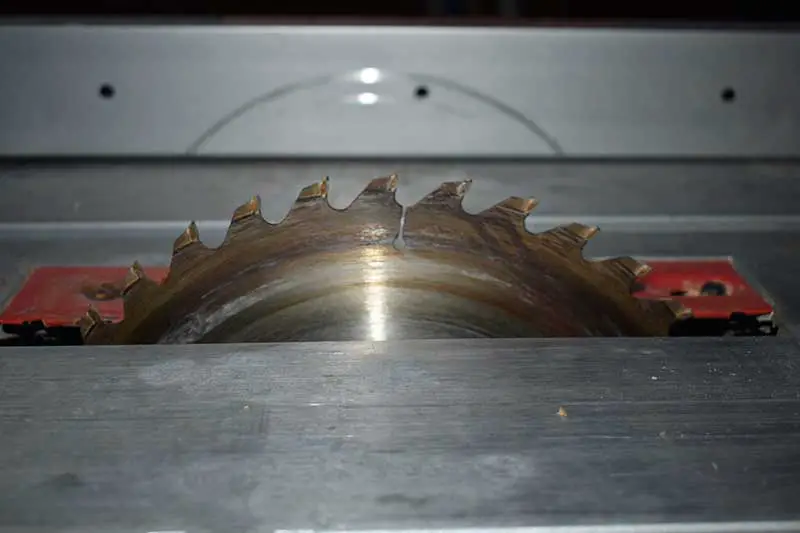A table saw blade may stop when touched due to a dull or damaged blade, an overheating motor, misaligned blade or arbor, or a loose or worn drive belt. Identifying the specific cause and taking appropriate steps to fix the issue will resolve the problem and ensure safe operation.

A table saw blade that stops when touched is a concerning issue that needs to be addressed immediately. There are several possible reasons for this problem, and understanding the underlying cause is essential to find the right solution. This article will discuss the reasons why a table saw blade may stop when touched and the step-by-step solutions to resolve the issue.
Dull or Damaged Blade
A dull or damaged blade can cause the saw to struggle to cut through the material, which may lead to the blade stopping when touched. The blade may have chipped or missing teeth, or it may simply be too dull to cut efficiently.
How to Fix a Dull or Damaged Blade
- Turn off the table saw and unplug it from the power source.
- Carefully inspect the blade for any signs of damage, such as chipped or missing teeth.
- If the blade is dull or damaged, replace it with a new, sharp blade. To change the blade, follow these steps: a. Remove the blade guard and any other safety devices. b. Use a wrench to loosen the arbor nut that secures the blade to the saw. c. Remove the old blade and replace it with the new one. d. Tighten the arbor nut and reattach the blade guard and safety devices.
Overheating Motor
An overheating motor may lose power and stop when cutting material. Overheating can be caused by excessive load, poor ventilation, or a malfunctioning motor.
How to Fix an Overheating Motor
- Ensure proper ventilation around the table saw and avoid overloading the motor by cutting material that is too thick or hard for the saw’s capacity.
- Clean the motor housing and surrounding area to remove any dust or debris that may be blocking air vents and affecting the motor’s cooling system.
- If the motor continues to overheat, it may be necessary to replace the motor or have it serviced by a professional.
Misaligned Blade or Arbor
A misaligned blade or arbor can cause the blade to bind and stop when cutting. The misalignment may be due to wear and tear, loose components, or improper assembly.
How to Fix a Misaligned Blade or Arbor
- Turn off the table saw and unplug it from the power source.
- Check the blade and arbor for any signs of misalignment. The blade should be parallel to the miter gauge slot, and the arbor should be square to the table.
- If the blade or arbor is misaligned, follow these steps: a. Consult your table saw’s user manual for instructions on how to adjust the blade and arbor alignment. b. Use a combination square or a dial indicator to measure and adjust the alignment accurately. c. After making the necessary adjustments, reassemble the table saw and check the alignment again.
Loose or Worn Drive Belt
A loose or worn drive belt may slip when cutting, causing the blade to stop. Over time, the drive belt may stretch or wear out, leading to a loss of tension and reduced power transmission.
How to Fix a Loose or Worn Drive Belt
- Turn off the table saw and unplug it from the power source.
- Remove the motor cover to access the drive belt.
- Inspect the belt for signs of wear, such as fraying or cracking. If the belt is worn, replace it with a new one.
- If the belt is loose but not worn, adjust the tension according to your table saw’s user manual.
- Reassemble the table saw and test the blade’s performance.
By addressing the potential causes mentioned above, you can effectively fix a table saw blade that stops when touched. Regular maintenance and inspection will help prevent such issues from occurring in the future, ensuring your table saw operates efficiently and safely.
| Issue | Solution |
|---|---|
| Dull or damaged blade | Sharpen or replace the blade as needed |
| Loose blade | Tighten the blade properly using a blade wrench |
| Overloaded motor | Reduce workload, use a thinner blade, or upgrade to a more powerful motor |
| Motor capacitor failure | Replace the motor capacitor |
| Damaged drive belt | Inspect the drive belt and replace it if necessary |
| Overheating | Allow the saw to cool down before resuming operation, and ensure proper ventilation |
| Poor power supply | Check and repair any issues with the power supply or switch to a dedicated circuit if needed |
